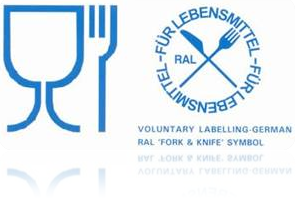
In September 2005, the German New Food and Dietary Products Act LFGB replaced the Food and Daily Necessities Act LMBG. It is also known as the 'Food, Tobacco Products, Cosmetics, and Other Daily Necessities Management Law', which is the most important basic legal document in the field of food hygiene management in Germany. It is the guideline and core for the formulation of other specialized food hygiene laws and regulations. But in recent years, there have also been modifications, mainly to match European standards. The regulations provide general and fundamental regulations for all aspects of German food, and all food and food related daily necessities in the German market must comply with the basic regulations mentioned above. Daily necessities that come into contact with food have been tested and meet the requirements of Articles 30 and 31 of the German Food and Daily Necessities Law. They can be certified as 'products that do not contain chemical toxic substances' by an authorized institution through an LFGB testing report and can be sold in the German market.
1、 The Meaning of LFGB Certification Knife and Fork Mark

2、 The LFGB certified knife and fork logo is a food safety label.
If there is a knife and fork mark on daily necessities that come into contact with food, it indicates that the product has passed testing and meets numerous German and European standards, meets the requirements of the German LFGB regulations, proves that it does not contain toxic substances that pose a threat to human health, and can be sold in Germany and other European and American markets.
In the European market, products with a knife and fork logo can enhance customers' confidence and purchasing desire, making them a powerful market tool and greatly increasing their competitiveness in the market.
3、 Test Product Classification Catalog
The range of LFGB food contact materials is very wide, and materials that may come into contact with food, such as tableware, food packaging, baking paper, cooking utensils, etc., whether they are plastic, rubber, glass, metal, or other materials, or coatings, are all food contact materials and require European food grade testing. The common testing product ranges are shown in the table below:
Tableware (Plastic, glass, ceramic, melamine, rubber, paper, wood)
| Cups, plates, bowls, plates, knives, forks, spoons, ladles, lunch boxes, disposable tableware, tea sets, wine sets, bottles, coffee sets, etc |
Kitchenware | Electric kettle, egg cooker, juicer, soybean milk machine, spoon, shovel, bottle opener, egg beater, cutting board, fruit knife, kitchen knife, plane, shovel, mixer, etc |
Cooking utensils and stoves | Pressure cooker, bread maker, frying pan, steamer, soup pot, hot pot, electric stove, other cooking utensils, stoves, etc |
Kitchen appliances | Household water purifiers, electric kettles, electric cups, microwaves, toasters, ovens, ovens, water dispensers, ovens, rice cookers, rice cookers, etc |
Insulated container | Hot water bottles, thermos cups, thermos pots, thermos bottles, thermos buckets, etc |
4、 LFGB food grade testing project
General plastic products: comprehensive migration, sensory testing
PVC plastic products: comprehensive migration testing, vinyl chloride monomer testing, peroxide value testing, sensory testing
Melamine resin products: comprehensive migration test, formaldehyde release test, sensory test
PE plastic products: comprehensive migration testing, peroxide value testing, chromium content testing, vanadium content testing, zirconium content testing, sensory testing
PS, ABS, SAN, Acrylic plastic products: comprehensive migration testing, peroxide value testing, total organic volatile matter (VOM), sensory testing
PA, PU plastic products: comprehensive migration test, peroxide value test, aromatic amine migration test, sensory test
PET plastic products: comprehensive migration test, zinc content test, lead content test, comprehensive migration test, peroxide value test
Silicone rubber products: 3 comprehensive migration tests, (VOM) organic volatile matter content, peroxide value test, organic tin compound test, sensory test
Rubber products: 3 comprehensive migration tests, formaldehyde dissolution test, zinc content test, lead content test, aromatic amine migration test, nitrosamine content test, sensory test
Paper products: (PCP) pentachlorophenol test, (pb cd hg CrVl) heavy metal (lead, cadmium, mercury, hexavalent chromium) release, antibacterial component migration test, formaldehyde content test, glyoxal release test, colored paper products - additional azo dye test
Products with non stick coating (non stick pot): 5 comprehensive migration tests, phenol dissolution test, formaldehyde dissolution test, aromatic amine dissolution test, (Vl) hexavalent chromium dissolution test, (lll) trivalent chromium dissolution test, PFOA perfluorooctanoic acid ammonium test, sensory test
Metals, alloys, and electroplated products: heavy metal dissolution (lead, cadmium, chromium, nickel) testing, sensory testing
PP plastic products: comprehensive migration testing, chromium content testing, vanadium content testing, zirconium content testing, sensory testing
Baked paper products: appearance, thermal stability, antibacterial component migration test, polychlorinated biphenyls test, formaldehyde release test, sensory test
Wood products: (PCP) pentachlorophenol test, formaldehyde release test, sensory test
Ceramic, glass, and enamel products: lead and cadmium dissolution test for parts in contact with food, and additional lead and cadmium dissolution test for cups